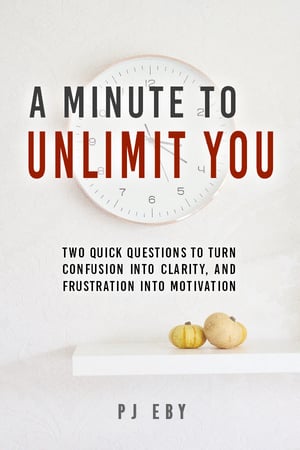Well, for about a week after I got back from PyCon I was doing great. I was burning up my to-do lists like there was no tomorrow. Excited, enthusiastic, stretching my abilities and loving every minute of it. I was in hyper-productivity beyond any that I think I have ever experienced in my life.
No, PyCon had nothing to do with it. I had already been revving up before Pycon, after getting back from that workshop. I just hadn’t set any specific timeframes or started taking action yet.
But after a week of super-speed, I suddenly found myself back to what had been “normal” for me. During that week, I pretty much always knew what I was going to do next, and was deeply involved in whatever it was. But by the weekend, I was more or less adrift, uncertain, and without direction.
I didn’t really know what happened to me at the time. A couple of days later I got moving again, by using a new twist on an old technique.
Many time and project management books will tell you that the best way to plan is to work backwards from the end of your project to the beginning, visualizing prerequisite upon prerequisite until you arrive back at the present moment.
Remembering The Future
What they don’t usually suggest, however, is that instead of imagining the steps, you simply remember them instead. This change has little impact on the content of the planning, but it makes a big difference in emotional tone.
In the straightforward way of doing this kind of planning, it’s as if you face yourself toward the future, standing in front of your goal, and then gradually step backwards to fill in the details. As you go backward, away from your goal, these details then obscure your view of the goal completely, until you have a huge series of things in front of you that have to get done.
Naturally, by the time I’m done planning something this way, I don’t want to even think about it any more; it’s clearly way too much work!
What I discovered was that you can reverse this if you orient yourself backwards in time, by imagining that it is now after the completion of your project, and you are looking back into the past to “remember” how you already accomplished it.
Now, as you visualize deeper into the past, the implementation details are mostly obscured by the view of the achieved goal, and the details simply add a kind of richness and sense of reality to your picture of the achieved goal. And as you “remember” having done the various parts, there is no sense of anything being an actual obstacle, nor any feelings of deadline pressure or that there is a lot to do.
And then, the final and unexpected bonus: the first time I finished visualizing my day this way, I discovered that my body seemed to know what to do all on its own. As I walked past things, my hands would reach out and automatically pick up or put down things according to what needed to be done. It was if I had put certain aspects of my day on auto-pilot!
So that was really cool, and it put me back into hyper-productivity for a few days before I stalled out again. I had been thinking about writing up this technique a few days ago, except that I wanted to be sure that the technique really worked, and it wasn’t just some natural ebb and flow of my energy that was causing the stops and starts.
So, in a way, getting stuck again was useful because it gave me an opportunity to test what was going on – and as it happens, to try another technique.
Verbal Overshadowing
I’m not sure why, exactly, but when I stalled out again this weekend, I never quite managed to pull off the time-reversal trick. One of the most annoying things about experimenting with a new mind hack is that you can lose it to “verbal overshadowing”, which is where your attempts to verbally describe an experience end up replacing your actual memory with the just the parts that were included in the description.
For example, once I wrote the article about stretching, I wasn’t actually able to do it as well as I did before! I think my verbal description left out a few key pieces of the mental state required, which include curiosity and anticipation. (Once I got those pieces in place, I recovered most of the ability.)
The same was true, I think, with my attempt at repeating the time reversal trick. When I tried to do it this weekend, I was just sort of willing myself to do it, the way I described in Being the Body. Not entering the “command mode” and actually visualizing, but just verbally commanding myself to visualize and “remember the future” of my day.
So, I’m trying to learn to be wary of verbal overshadowing, and focus as squarely as possible on the actual mental experience, without trying to describe it too much. In particular, describing something before I can repeat it at will seems like a very bad idea, despite my eagerness to report on all the new mind hacks I discover.
But this evening I discovered the real reason that I ran into problems two weekends in a row, and what to do about it. And it didn’t have any direct connection with the time-reversal hack, as it turns out.
Avoidance is an “Avoid Dance”
Specifically, the issue was that I was in each case planning to do some bookkeeping work on the weekend, helping out with the accounts for Leslie’s store. I’ve been putting it off like crazy, which is why they’re so far behind – and thus even more unpleasant to consider doing.
And so I’d get to the part of my week where I was trying to visualize this stuff as part of an overall plan for the weekend, and I kind of kept drawing a blank on it.
Well, “drawing a blank” makes it sound more obvious than it actually was. Try this: hold your hand out to one side of your head, while you look straight ahead. Move your hand forward enough so that you can just barely see it without turning your eyes or head. Now move your hand back slightly, while still looking forward.
Isn’t that weird? Suddenly, you become aware that your field of vision actually has an edge to it. Beyond that edge, things just cease to exist. It’s not that there’s blackness there, there’s just no there there. Normally, you don’t notice this non-“there”ness, because you’re focused on whatever’s actually in your field of vision.
And that’s sort of what happened to me when I tried to make any sort of plan that included the bookkeeping. My brain would sort of just slide right past and forget that I was going to be planning. There was this black hole in my head where the plan was supposed to be, and I’d end up surfing the net or doing something else.
By today it got really frustrating, because on a conscious level I was really determined to do some of the bookkeeping today. It was the only day of “weekend” I had left to do it in, after all. But almost all of the day just slid down that same mental black hole as parts of yesterday did.
So finally, a couple of hours ago, I figured out what was happening, and devised an experiment to see if I could fix the problem.
Applying some “Horse Sense”
Here was my theory: if the subconscious “other self” is like a horse, and “I” am like the rider, then if the horse balks at doing something, there is a reason, and I need to understand what it is. The horse will not proceed unless the rider communicates that he has perceived the obstacle, and assures the horse that no harm will result from going forward.
In fact, this idea is very closely correlated with the concept I presented in Doing It Anyway – the idea that the most successful way to change yourself is to face and accept the costs of the change, not just the benefits. What I didn’t realize until this evening is that the same concept is just as applicable to unpleasant individual tasks, as it is to changing one’s major habits.
As soon as I realized this, I went straight to my computer to write this article – and then stopped because I needed to test it first by actually doing some bookkeeping!
So I mentally guided my “horse” towards the task. I’ve been finding recently that the horse-and-rider metaphor is very useful for understanding and gaining rapport with my subconscious mind. For one thing, it makes it pretty clear I’m not going anywhere without the horse, and while you can encourage the horse to do things, you can’t really “make” it do anything.
You can often pull on the reins and stop it, if you’re paying attention and can react quickly enough, but if the horse really doesn’t want to move, there’s nothing you can do about it. Beating a horse that doesn’t want to go, only makes it mad at you, or maybe scared.
But on the positive side of this metaphor, the horse is stronger than you and a lot faster, and if you treat it right, you don’t have to work very hard at all; it’ll do everything for you. You just need to convince it to do what you want it to do, and provide some guidance as needed.
So, the “horse” was really relaxed about the bookkeeping at first, because my insight into the problem had resulted in an implicit acknowledgment and acceptance of the horse’s message. That is, it had effectively been saying “Are you sure you want to do this?” And I was now effectively saying, “yes, I’m sure, please proceed”.
And it was surprisingly easy, as I stood back and let the horse take over. I mostly watched as he downloaded the files I needed, upgraded the accounting software, and dug out some of the paperwork. I decided to just do one month’s credit card statements, enough to feel confident that I was back in the groove before I would then write up this article.
The first credit card statement was finished before I knew it, but the second one rapidly became more difficult. My “horse” balked about 8 or 9 times, sometimes getting panicky at apparently missing documents, confused categorization, and other issues. When he did, I would stop to mentally reassure him, as though I were calming an actual horse. Instead of trying to dodge the fears and anxiety and upset I was experiencing, I looked directly into the heart of what I was feeling, and named it.
“Ah,” I would say. “I’m afraid that I won’t do this right. I’m afraid that the tax deadlines will come and we won’t be able to find the missing paperwork. I’m afraid that we will have no way to account for these other things. I’m afraid that I will get so caught up in fixing these problems that I will never be able to keep track of what I did or didn’t do so far. I feel like it’s the morning of a big test that I somehow forgot to study for. I feel like I have to be at the airport now, and I forgot to pack.”
And then, each time, I would slowly sort through the problem, as if untangling the horse from a thicket. I would figure out a way to record the information needed, to track my progress, and so on. And then, he and I would move on.
No wonder I had been putting this off!
Fear is the Mind-Killer
And yet – there was no need to. The problem wasn’t just that the accounting was a scary forest where my “horse” feared to tread; it was that I wasn’t paying attention to what he was trying to tell me. Instead of examining the fear and understanding my resistance, I was trying to say “just do it” and hope that something magical would happen so I wouldn’t have to actually feel the fear or face the problems.
But you know, I read somewhere once that if you tell a kid not to be scared of the monsters under his bed, you’ll just frighten him more. But if you acknowledge that having monsters under the bed would indeed be scary, then he calms down.
For that matter, if you tell grown-ups to calm down about pretty much anything, it doesn’t work. But if you acknowledge whatever feeling they’re trying to express, they’ll usually calm down much quicker.
Clearly, the same principle applies to one’s self. Your subconscious treats an unacknowledged message as an unreceived message: it retransmits it, over and over again, until you accept it and reply. You can ignore the message as much as you want, but this doesn’t actually make the problem go away.
It’s just another reason why “willpower” and so-called “self-discipline” don’t actually work. Sure, there are some people who claim to have these things, but I believe that these people either:
- don’t have fears that relate to the areas where they have this supposed “discipline”, or
- have simply learned the knack of “feeling the fear and doing it anyway”.
Luckily for the rest of us, the good news is that this can be learned – it’s not merely a matter of beating yourself up until you somehow become “tough”. Indeed, the secret is the very opposite of beating yourself up!
And perhaps, as you learn to treat yourself with care, and as your “horse” unlearns its fears and learns to trust you, other people will come to believe that you too have this mythical “self-discipline” thing. But in fact, all you will really have – or need – is self-compassion, and self-trust.










Another excellent entry. Thankyou Phillip.
I also stalled this weekend – I just tried to listen to why, and it was enlightening! My confidence is now restored, thanks!
As a sidenote, I’d love to see your writings in printed form – I can think of several members of my circle of friends/family that could learn a great deal from your techniques, but don’t have/like the Internet. Are there any plans afoot for this?
“””Are there any plans afoot for this?”””
Did you mean something more like a newsletter? Book? Audio CDs? Video? Correspondence course? Or did you just mean a collection of the essays?
I’m very interested in finding out what my readers would be most interested in buying, as this would be very helpful for putting a deal together so the material could actually be produced.
I suspect, however, that most people who “don’t have/like the Internet” are going to be less interested in my essays in their current form, than in focused material that directly trains them in the use of the techniques.
Such material would probably also be useful even for the people who already read this blog, because my essays here focus more on concepts, discovery, and motivation to practice them, than they do on trying to actually train anybody how to do anything. So, as a couple of people have already pointed out, some training resources would be good to have.
But I’d be interested to know what you and your friends/family think, one way or the other.
Ok, thanks! I was optimistically thinking of a book that I could give as a gift to members of my family 🙂
I was actually thinking quite selfishly. My father uses NLP for business in a management consultancy role. If I’m honest, I’m yet to be convinced – the writings he uses (that I’ve read, anyway) smell of quackery and false idealism. I find your writings more, I don’t know, believable. Maybe this is because I can associate more with your situations, as opposed to generic techniques to ‘perform better’ and ‘achieve more’ and other such nebulous, ungrounded terms.
Actually, the book wouldn’t need to be a great deal more than the collection of essays with suitable cross references (obviously, you now have the benefit of hindsight 🙂 for me/people I know to get value out of it. And in relation to your latest entry on rememering to use your techniques, a ‘cheat sheet’ would be ideal!
Anyway, just rambling thoughts. Thanks again!
I found your site by accident, while searching for who wrote this quote” Imagine
what we would do , if we knew we would not fail ” or something like that.
HOw true that is.
I Need to learn how to
” just do it ‘ and
other things that are positive that you write about. I grew up as a teenager homeless, and
was on my own since I was 14. Those of us
who grew up without
parental guidence, usually have all sorts of problems dealing with life as adults. I sure do . Your book would be good for those incarcerated as well, they need life skills to succeed . I am working towards writing a book to help them do that , if I can ever ” just do it ” , LOL,, anyway ,
enjoy your writings.
I really like your articles, but I would like to know HOW you are making these changes in your mind. Do you have articles or anything that explains the techniques you are using? Especially when it comes to irrational fear and congruent changes.
I have tried certain NLP techniques like the rewind phobia and some anchoring but they never really worked. I have also tried hypnosis but as you said, those old pathways are still there and will resist the new ones. I would really like to know how you’re making changes. Thanks a lot.
I like your analogy. Nice and simple, sort of the “horse whisperer”.
I have the same problem. Leave work on Friday thinking of all the things I want to achieve over the weekend. Come Sunday afternoon I get dirty with myself for fluffing around all weekend and achieving nothing.
I have always found looking into my own soul for the reasons of these fears the hardest thing to do. Any suggestions on how you can approach this, or is a case of time and patience with a lot of self-reflection? Then what do you do? DO you just acknowledge it, or do you actively seek to change that belief?
Thanks for any advise you could offer.